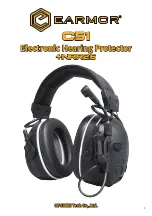
CAUTION
Overloading due to unusual activities
>
Falling due to unexpected product behaviour as the result of a malfunction.
>
Falling due to breakage of load-bearing components.
>
Skin irritation due to defects on the hydraulic unit with leakage of liquid.
►
The product was developed for everyday use and must not be used for unusual activities. These unusual activ
ities include, for example, extreme sports (free climbing, parachuting, paragliding, etc.), sports activities that
involve jumping, sudden movements or fast sequences of steps (e.g. basketball, badminton, sporty riding).
►
Careful handling of the product and its components not only increases their service life but, above all, ensures
your personal safety!
►
If the product and its components have been subjected to extreme loads (e.g. due to a fall, etc.), then the
product must be inspected for damage immediately. If necessary, forward the product to an authorised
Ottobock Service Centre.
4.10 Notes on the movement patterns
CAUTION
Improper use of the stance function
Falling due to unexpected product behaviour because of changed damping behaviour.
►
Make sure that the patient is standing safely when using the stance function and checks the lock of the knee
joint before placing their full weight on the orthosis.
►
Instruct the patient in the correct use of the stance function. Information on the stance function see Page 84.
CAUTION
Walking up stairs
>
Falling due to foot being placed incorrectly on stair as a result of changed damping behaviour.
>
Falling due to breakage of load-bearing components.
►
Ensure that the patient uses the handrail when walking up stairs and places most of the sole of the foot on the
stair surface.
►
Always step up with the less affected leg, followed by the leg with the product.
►
If there is a connection to a foot component, support by bouncing with the product extended while walking up
stairs is not allowable and therefore has to be avoided.
►
Particular caution is required when carrying children up the stairs.
CAUTION
Walking down stairs with moveable orthosis foot component
Falling due to foot being placed incorrectly on stair as a result of changed damping behaviour.
►
Inform the patient that the handrail always has to be used when walking down stairs, and that most of the sole
of the foot has to be set onto the stair surface.
►
The warnings and error signals have to be observed (see Page 107).
►
Notify the patient that resistance in the flexion and extension direction can change in case of warnings and
error signals.
►
Particular caution is required when carrying children down the stairs.
CAUTION
Walking down stairs with rigid orthosis foot component
Falling due to foot being placed incorrectly on stair as a result of changed damping behaviour.
►
Inform the patient that the handrail always has to be used when walking down stairs, and that the patient has
to roll over the edge of the step with the middle of the shoe.
►
The warnings and error signals have to be observed (see Page 107).
►
Notify the patient that resistance in the flexion and extension direction can change in case of warnings and
error signals.
►
Particular caution is required when carrying children down the stairs.
73
C-Brace joint unit 17KO1=*
Safety
Summary of Contents for 17KO1 Series
Page 4: ...4 C Brace joint unit 17KO1...
Page 114: ...114 C Brace joint unit 17KO1...
Page 115: ...115 C Brace joint unit 17KO1...
















































